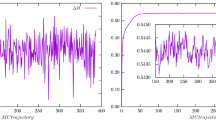Summary
An analysis of experimental facts in low- and high-energy hadron interactions and theoretical results in gauge field theory leads to the conclusion that theSU 6 totally spontaneously broken, temporary free gauge field model is a natural candidate for a description of strong hadron interactions. The model is based on the observed massive vector mesons and fermions. It is shown that the Higgs sector can be chosen in such a manner that—even after totalSU 6 symmetry breaking—there survives a global symmetrySU 2×U s1 ×U c1 ×U b1 ×U t1 which coincides with the observed isospin, strangeness, charm, beauty and top symmetry. The renormalization group analysis indicates that the model is temporarily free. It is shown that all vector mesons reggeize and their parent and daughter Regge trajectories are calculated in the leading-logarithm approximation. It is shown also that all fundamental fermions which can be taken either in vector or adjoint representation also reggeize. Due to temporary freedom the model possesses the scaling properties and enables a perturbative analysis of high-energy of processes. Since the model is based on observed hadrons the analysis of exclusive processes is considerably facilitated. It is shown, in particular, that the model predicts a new form of baryon-baryon and baryon-antibaryon high-energy total cross-section: it is noteworthy that the obtained cross sections are decreasing for moderately high energy and increasing for higher energies in a remarkable agreement with experimental data in the energy interval 10 GeV\(\underset{\raise0.3em\hbox{$\smash{\scriptscriptstyle\thicksim}$}}{< } \sqrt s \underset{\raise0.3em\hbox{$\smash{\scriptscriptstyle\thicksim}$}}{< } \)30 000 GeV.
Riassunto
Un'analisi degli eventi sperimentali nelle interazioni degli adroni ad alta e bassa energia e dei risultati teorici nella teoria del campo di gauge porta alla conclusione che il modello del campo di gaugeSU 6 totalmente, spontaneamente infranto temporaneamente libero, è un candidato naturale per una descrizione delle interazioni adroniche forti. Il modello si basa sui mesoni vettoriali dotati di massa e fermioni osservati. Si dimostra che il settore di Higgs può essere scelto in maniera tale che—anche dopo una totale rottura della simmetriaSU 6—rimane una simmetria globaleSU 2×U s1 ×U c1 ×U b1 ×U t1 che coincide con l'osservata simmetria di isospin, stranezza, charm, beauty e top. L'analisi del gruppo di rinormalizzazione indica che il modello è temporaneamente libero. Si dimostra che tutti i mesoni vettoriali reggeizzano e le loro traiettorie di Regge progenitrici e figlie si calcolano con l'approssimazione del logaritmo principale. Si dimostra anche che tutti i fermioni fondamentali sia in rappresentazione vettoriale che aggiunta, reggeizzano. A causa della libertà temporanea, il modello possiede le proprietà di scala e permette un'analisi perturbativa dei processi ad alta energia. Poiché il modello si basa su adroni osservati, l'analisi del processo esclusivo è notevolmente facilitata. Si dimostra, in particolare, che il modello prevede una nuova forma di sezione d'urto totale ad alta energia barione-barione e barione-antibarione: è degno di nota che le sezioni d'urto ottenute diminuiscono ad energie moderatamente alte e aumentano ad energie maggiori in notevole accordo con i dati sperimentali nell'intervallo di energia Gev\(\underset{\raise0.3em\hbox{$\smash{\scriptscriptstyle\thicksim}$}}{< } \sqrt s \underset{\raise0.3em\hbox{$\smash{\scriptscriptstyle\thicksim}$}}{< } \) 30 000 GeV.
Резюме
Анализ экспериментальных данных по взаимодействиям адронов с низкими и высокими энергиями и теоретические редультаты в калибровочной теории поля приводят к выводу, чтоSU 6 спонтанно нарушенная модель временно свободного калибровочного поля представляет естественный кандидат для описания сильных взаимодействий адронов. Эта модель основана на наблюдаемых массивных векторных мезонах и фермионах. Показывается, что сектор Хигтса может быть выбран таким образом, что после полного нарушенияSU 6 симметрии существует глобальная симметрияSU 2×U s1 ×U c1 ×U b1 ×U t1 , которая совпадает с наблюдаемой симметрией изоспина, странности, щарма, красоты (прелести) и верха (истины), Анализ группы перенормировки показывает, что предложенная модель временно свободная. Вычисляются траектории Редже в старшем логарифмическом приближении. Также показывается, что все фундаментальные фермионы, которые могут быть взяты либо в векторном, либо в сопряженном представлении, также реджеизованы. Вследствие временной свободы, предложенмая модель обладает свойствами
Similar content being viewed by others
Footnotes
See,e.g., i)J. G. Rushbrooke:Hadronic interactions at highest energies, preprint CERN-EP/85-178 (1985); ii)M. K. Carter, P. D. B. Collins andM. R. Whalley:Compilation of nucleon-nucleon and nucleon-antinucleon elastic scattering data, preprint Rutherford Appleton Laboratory RAL-86-002 (January 1986).
See,e.g.,H. Chen andT. T. Wu:Phys. Rev.,182, 1899 (1969);186, 1611 (1969);Phys. Rev. Lett.,24, 1456 (1970); inProceedings of the 1971 International Symposium on Electron and Photon Interactions at High Energies, edited byN. B. Mistry (Cornell University Press, Ithaca, N. Y., 1972), p. 147.
V. S. Fadin, E. A. Kuraev andL. N. Lipatov: i)Ž. Ėksp. Teor. Fiz.,71, 840 (1976); ii)79, 377 (1977).
C. Bourrely, J. Soffer andT. T. Wu:Nucl. Phys. B,247, 15 (1984);Phys. Rev. Lett.,54, 757 (1985).
J. M. Cornwall, D. N. Levin andG. Tiktopoulos:Phys. Rev. D,10, 1145 (1974).
Particle Data Group:Review of particle properties, Phys. Lett. B,170, 1 (1986).
See,e.g., i)P. D. B. Collins:An Introduction to Regge Theory and High Energy Physics (Cambridge University Press, London, 1977); ii)A. Martin:Regge trajectories in the quark model, preprint CERN-TH. 4259/85 (1985).
See,e.g., i)M. T. Grisaru andH. J. Schnitzer:Phys. Rev. D,20, 784 (1979);21, 1952 (1980); ii)V. S. Fadin andV. E. Sherman Ž. Ėksp Teor. Fiz.,72, 1640 (1977); iii)L. Łukaszuk andL. Szymanowski:Nucl. Phys. B,159, 316 (1979); iv)L. Szymanowski:Nucl. Phys. B,173, 93 (1980).
See,e.g., i)H. Cheng andC. C. Lo:Phys. Lett. B,57, 177 (1975); ii)M. T. Grisaru:Phys. Rev. D,16, 1962 (1977); iii)P. H. Dondi andH. R. Rubinstein:Phys. Rev. D,18, 4819 (1978).
See,e.g., i)M. M. Nagels, T. A. Rijken andJ. J. de Swart:Phys. Rev. D,12, 744 (1975);15, 2547 (1977);17, 768 (1978);20 1633 (1979). ii)R. Vinh Mau:The Paris nucleon-nucleon potential—new developments, inProceedings of the Workshop on Nuclear Physics with Real and Virtual Photons, Bologna, Italy, Lecture Notes in Physics, Vol.137, edited byH. Arenhövel andA. M. Saruis.
See,e.g., i)J. Fleisher andJ. A. Tion:Nucl. Phys. B 84, 375 (1975);Phys. Rev. D,15, 2537 (1977); ii)K. Fabricius andJ. Fleischer:Phys. Rev. D,19, 353 (1979); iii)K. Fleischer andM. Pindor:Phys. Rev. D,24, 1978 (1981).
See,e.g.,L. D. Faddeev andA. A. Slavnov:Gauge Fields: Introduction to Quantum Theory (Benjamin/Cummings, Reading, Mass., 1980).
See,e.g., i)S. A. Anikin, O. I. Zavialov andN. I. Karchev:Teor. Mat. Fiz.,44, 291 (1980);46, 3 (1981); ii)G. B. West:Phys. Rev. D,27, 1878 (1983). iii) See alsoF. T. Brandt andJ. Frenkel:Infrared behaviour of three and four gluon vertices in Yang-Mills theory, preprint University of São Paulo, IFUSP/P-538 (1986), and references contained therein.
R. Oehme andW. Zimmerman:Phys. Rev. D,21, 471, 1661 (1980).
P. Rączka andR. Rączka:Infrared stable fixed point in QCDmodels with six flavours or more and the problem of quark confinement, preprint Geneva University UGVA-DPT 1986/03-494.
A. O. Barut andR. Rączka:Int. J. Modern Phys. A,2, 265 (1987).
R. Rączka: i)Phys. Rev. D,31, 1146 (1985); ii)Czech. J. Phys. B,37, 421 (1987).
F. J. Yndurain:Quantum Chromodynamics (Springer-Verlag, New York, N. Y., 1983).
See,e.g., i)T. P. Cheng, E. Eichten andL.-F. Li:Phys. Rev. D,9, 2259 (1974); ii)E. S. Fradkin andO. K. Kalashnikov:J. Phys. A,8, 1815 (1975);Phys. Lett. B,59, 159 (1975);64, 177 (1976); iii)B. L. Voronov andI. V. Tyutin:Sov. J. Nucl. Phys.,23, 664 (1976).
H. D. Politzer andG. G. Ross:Nucl. Phys. B,75, 269 (1974).
K. Han, C. Klopfenstein, G. Mageras, H. Dietl, G. Eigen, V. Fonseca, P. Franzini, J. E. Hotstkotte, R. Imlay, J. Lee-Franzini, G. Levman, E. Lorenz, D. M. Lovelock, W. Metcalf, L. Romero, R. D. Schamberger, D. Son, V. Sreedhar, P. M. Tuts, S. Youssef andT. Shao:Phys. Rev. Lett.,55, 36 (1985).
See,e.g., i)R. K. Bock (UA1Collaboration) inProceedings of the XXII International Conference on High Energy Physics, Leipzig, 1984, Vol.2, edited byA. Meyer andE. Wieczorek (Akademie der Wissenschaften der DDR, Zeuthen, 1984), p. 2; ii)L. Di Lella:Physics from the p\(\overline {\text{p}} \) collider, inProceedings of the International Conference on High Energy Physics, Bari, 1985 (European Organization for Nuclear Research), to be published; iii)L. Dobrzyński:Status report on the serch for top quark, inProceedings of the International Conference on Physics in Collision, Autun 1985, to be published.
Proceedings of the XXII International Conference on High Energy Physics, Vol.1 and2, edited byA. Meyer andE. Wieczorek (Leipzig, 1984).
Proceedings of the International Europhysics Conference on High Energy Physics, Bari, July 1985.
J. J. Sakurai:Ann. Phys. (N. Y.),11, 1 (1960).
A. Salam andJ. C. Ward:Nuovo Cimento,19, 165 (1961)
B. de Vit:Nucl. Phys. B,51, 237 (1973).
See,e.g., i)H. Georgi andS. L. Glashov:Phys. Rev. Lett.,32, 438 (1974); ii)O. K. Kalashnikov:Fortschr. Phys.,31, 591 (1983).
D. B. Lichtenberg:Unitary Symmetries and Elementary Particles, 2nd edition (Academic Press, New York, N. Y., 1979).
S. Weinberg:Phys. Rev. D,7, 1068 (1973).
T. Murphy, L. O'Raifeartaigh andM. Yamada:Symmetry breaking and renormalization effects for an SU n model with two scalar fields, preprint Dublin Institute for Advanced Studies DIAS-STP-84-12 (1984).
M. Pawłowski andR. Rączka:An analysis of Higgs sector in the temporarily free SU 6 gauge field theory model, in preparation.
P. Chankowski, J. Kraśkiewicz, M. Pawłowski andR. Rączka:Analysis of temporary freedom in gauge field theory models for strong interactions, in preparation.
i)C. Y. Lo:Nucl. Phys. B,157, 212 (1977); ii)H. Cheng:Lett. Nuovo Cimento,25, 175 (1979).
S. Mandelstam:Phys. Rev. B,137, 944 (1964);E. Abers andV. L. Teplitz:Phys. Rev. B,158, 1365 (1967).
R. Rączka andB. Sołek:An analysis of Regge trajectories in temporarily and asymptotically free gauge field theory models for strong interactions, in preparation.
Ya. Ya. Balitsky andL. N. Lipatov: i)Sov. J. Nucl. Phys.,28, 1597 (1978); ii)JETP Lett.,30, 383 (1979).
L. N. Lipatov:Bare pomeron in quantum chromodynamics, preprint L.I.Ya.P-1137/85, Leningrad (1985).
I. Ya. Pomeranchuk:Ž. Ėksp. Teor. Fiz.,34, 725 (1958).
P. Rączka andR. Rączka:High energy behaviour of baryon-baryon and mesonbaryon cross-sections, to be published.
R. Kirschner andL. N. Lipatov:Nucl. Phys. B,213, 122 (1983);R. Kirschner:Regge asymptotics of scattering amplitudes in the logarithmic approximation of QCD, preprint KMU HEP 85-08 Leipzig (1985).
R. Rączka:An asymptotically free SU 6 -gauge field theory model for strong interactions, in preparation.
T. Appelquist andJ. Carrazzone:Phys. Rev. D,11, 2865 (1975).
Author information
Authors and Affiliations
Additional information
Traduzione a cura della Redazione.
Переведено редакцией.
Supported in part by the contract No. 7F-5S1D of the Institute of Theoretical Physics of the Polish Academy of Sciences.
Rights and permissions
About this article
Cite this article
Rączka, R. A temporarily freeSU 6 gauge field theory model for strong interactions. Nuov Cim A 98, 297–336 (1987). https://doi.org/10.1007/BF02817967
Received:
Published:
Issue Date:
DOI: https://doi.org/10.1007/BF02817967



